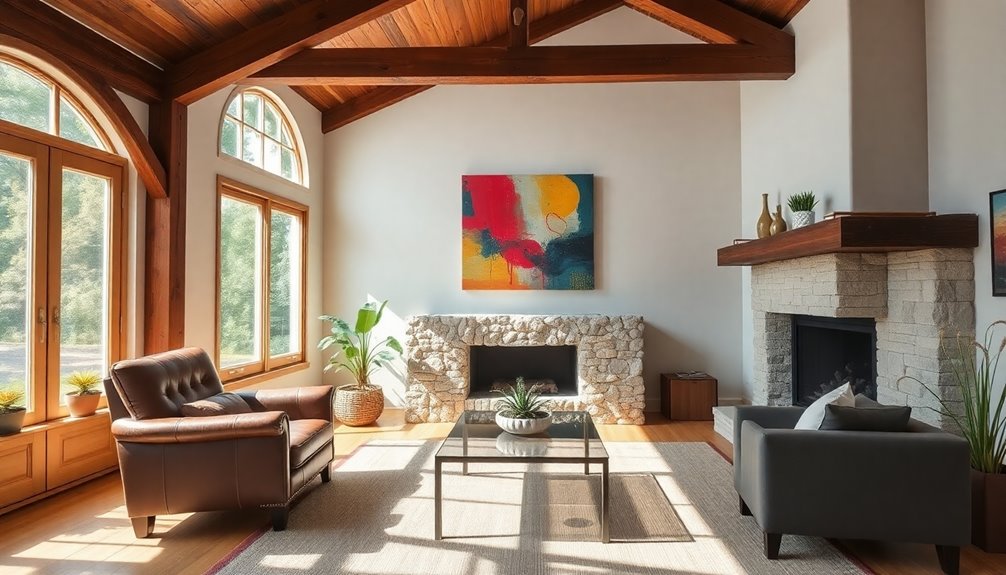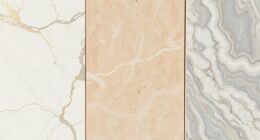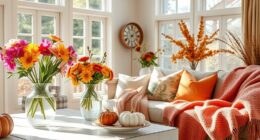To blend rustic and modern styles seamlessly, focus on combining natural materials with clean lines. Use a neutral color palette as your base, adding earthy accents for warmth. Mix vintage pieces with contemporary furniture to create depth and character. Incorporate varied textures by layering fabrics like wool and linen against sleek surfaces like glass and metal. Guarantee functionality with multifunctional furniture, offering comfort and practicality. Finally, personalize your space with unique decor that tells your story while considering sustainable options. With these tips, you can achieve a stunning fusion of rustic charm and modern elegance—keeping your design fresh and lively. By prioritizing quality over quantity, you can create a timeless fashion fusion that transcends trends. Embrace imperfections and asymmetry in your furniture and decor, adding an organic touch to your modern space. Consider investing in artisanal pieces and handmade accents to bring a sense of authenticity and individuality to your home. With these thoughtful details, your rustic and modern fusion will stand the test of time, creating a welcoming and unique environment.
Key Takeaways
- Combine rustic elements like reclaimed wood and natural stone with sleek modern materials such as glass and metal for a balanced aesthetic.
- Use a neutral color palette as a foundation, introducing earthy accent colors to create warmth and highlight unique design features.
- Incorporate multifunctional furniture pieces to enhance practicality while maintaining a cozy atmosphere with soft textiles and natural light.
- Personalize spaces with unique decor items, vintage finds, and handcrafted elements that reflect personal stories and experiences.
- Seek professional guidance to effectively blend styles, ensuring functional layouts and harmonious material selections that resonate with both rustic and modern aesthetics.
Overview of Rustic Modern Design
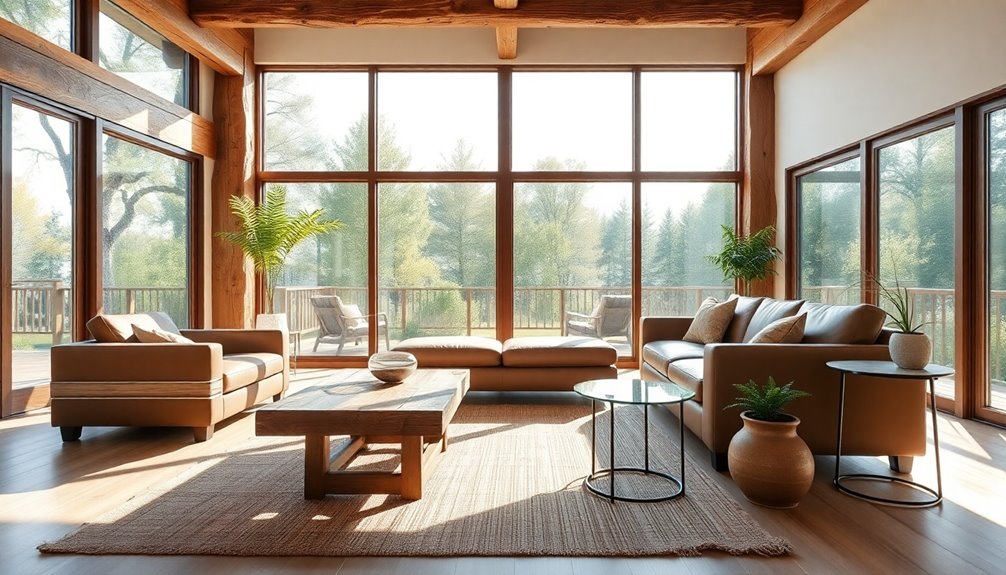
Rustic modern design beautifully blends the raw charm of nature with the sleek sophistication of contemporary aesthetics. This style merges rustic elements, like natural materials and earthy tones, with modern features, creating warm and inviting spaces. You'll find that it effectively combines vintage furniture with contemporary pieces, reflecting a unique blend of nostalgia and innovation. In this harmonious blend, a neutral color palette serves as the backdrop, allowing the rustic charm and modern accents to shine. Think of soft beiges and grays enriched with layered textures from wood, stone, and glass. Incorporating best woods for farmhouse tables not only enhances the rustic appeal but also ensures durability, making it a perfect choice for a lasting design. Additionally, using best daisy varieties in your garden can complement the rustic modern aesthetic by attracting pollinators and adding vibrant splashes of color.
For instance, many couples who embrace this style often host wedding highlights that showcase the beauty of rustic modern design through their decor choices. Lighting plays an essential role in rustic modern design, as large windows welcome natural light, while strategic fixtures add a modern touch. This thoughtful approach to lighting enhances the overall ambiance, making your space feel open and airy. Decluttering your space can also enhance the visual appeal of rustic modern design by creating mental clarity and allowing the unique features of your decor to stand out. As you explore rustic modern design, you'll appreciate the balance it strikes between comfort and sophistication, making it a perfect choice for creating stylish yet cozy environments.
Key Elements of the Blend
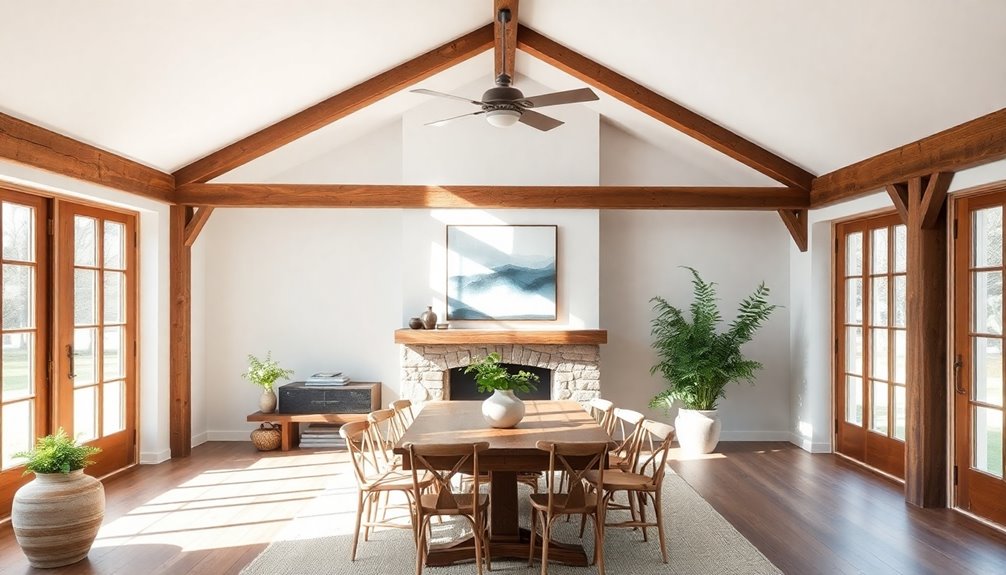
To create a seamless blend of rustic and modern styles, you need to focus on key elements like material combinations, color palette harmony, and texture mixing techniques.
Start by balancing organic materials with sleek finishes, while choosing a muted color palette that enhances the overall aesthetic. Incorporating natural elements can promote tranquility and elevate the mood in your space. For instance, the use of reclaimed wood as a statement piece can beautifully bridge the gap between rustic and modern design. Additionally, integrating vintage or distressed furniture can add authenticity and character to your decor. Incorporating neutral tones into your color scheme can create a calming backdrop for both rustic and modern elements. Don't forget to play with different textures to add depth and visual interest to your space.
Material Combinations for Balance
When it comes to achieving a balanced blend of styles, the right material combinations play a crucial role. Combining rustic and modern elements can create a seamless fusion that enhances your space's aesthetics and functionality. For instance, using reclaimed wood alongside sleek metals introduces rustic charm with modern sophistication, fostering a warm yet polished atmosphere.
Natural textures, like those found in stone countertops, not only add durability but also serve as striking focal points. They complement rustic cabinetry and modern appliances beautifully.
Textured fabrics such as linen and wool, paired with smoother materials like glass and concrete, introduce that fundamental mix of comfort and contemporary style, making your interiors inviting.
Incorporating industrial elements, like metal accents or exposed beams, against traditional wooden furnishings establishes a dynamic contrast that enriches the overall design narrative.
Layering different materials—like a reclaimed wood dining table paired with modern metal chairs—ensures depth and visual interest.
Color Palette Harmony
Finding the perfect color palette is essential for blending rustic and modern styles effortlessly. Start with a foundation of neutral tones, like whites and grays, which provide a calming backdrop.
Layer in earthy hues, such as terracotta and deep greens, to introduce warmth and texture. This combination promotes an inviting atmosphere that reflects the natural beauty of rustic materials while maintaining modern simplicity.
Accent colors like burnt oranges or deep navy can enliven your space without overwhelming it. Use these strategically to highlight key design elements, ensuring both rustic and modern aspects shine through.
Incorporating contrasting shades, such as dark wood tones against light-colored walls, adds depth and emphasizes the unique qualities of each style.
For a fresh perspective, consider soft pastels to modernize traditional rustic elements. They can harmonize with the earthy hues while ensuring that your design remains comfortable and approachable.
Texture Mixing Techniques
Blending rustic and modern styles goes beyond color palettes; it's all about mixing textures to create depth and interest. Effective texture mixing techniques enhance your space by contrasting rustic elements like reclaimed wood or natural stone with contemporary styles such as glass or metal. This interplay creates visual depth and interest that draws the eye.
Layering textiles is a powerful way to add warmth and character. Imagine combining soft linen pillows with a jute rug, which not only enhances comfort but also brings a cozy feel to your room. You can further evoke a rustic vibe by incorporating leather furniture alongside woven baskets, maintaining that contemporary touch while embracing authenticity. Adding Indonesian decorative pillows can also bring a vibrant cultural touch to your textiles. Incorporating natural fibers in your textiles enhances the overall farmhouse aesthetic. Additionally, using vibrant floral arrangements as accents can infuse your space with lively energy and cultural richness.
Don't forget about wall finishes! Textured options like shiplap or exposed brick can effectively balance rustic warmth with modern simplicity. Pair these with smooth, minimalist decor elements to foster an inviting atmosphere. Incorporating Indonesian decor masks can also enhance the cultural richness of your space, adding a unique storytelling element to your design.
Ultimately, the strategic combination of textures helps you create a layered look that feels both stylish and lived-in, ensuring your home reflects the perfect blend of rustic and modern design.
Design Tips for Success
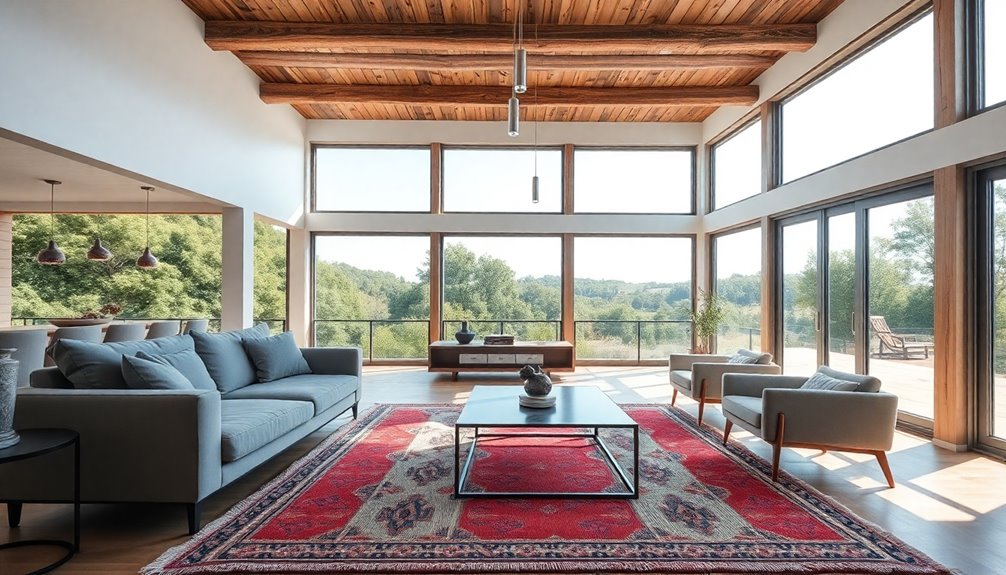
Creating a harmonious space that blends rustic and modern styles requires thoughtful design choices. Start with a neutral color palette that features earthy tones and whites, setting a serene backdrop for both rustic design and modern design elements. Mixing textures is essential; combine smooth modern surfaces like glass and metal with rougher rustic materials such as reclaimed wood and stone to enhance depth and visual interest. Additionally, sustainable materials can be utilized to reinforce both styles while promoting eco-friendliness. Incorporating natural materials adds warmth to the overall design, creating a seamless transition between rustic and modern elements. Furthermore, integrating outdoor living areas can extend the aesthetic appeal of your space into nature, enhancing the overall experience.
To help you navigate your design choices, consider the following table:
| Design Element | Rustic Touch | Modern Touch |
|---|---|---|
| Furniture | Farmhouse table | Sleek minimalist chairs |
| Lighting Fixtures | Vintage chandeliers | Industrial pendant lights |
| Color | Earthy tones | Crisp whites |
| Functionality | Storage ottomans | Extendable dining tables |
Balancing vintage and contemporary pieces guarantees that neither style overwhelms the other. Opt for statement lighting fixtures as focal points to accentuate the blend of rustic warmth and modern simplicity. Emphasizing functionality with multi-purpose furniture allows you to maintain practicality while achieving an inviting atmosphere. Additionally, consider incorporating indoor plants to enhance the overall aesthetic and improve air quality in your space.
The Role of Professional Guidance

Enlisting professional guidance can greatly elevate your design project, guaranteeing a seamless blend of rustic and modern styles. Interior designers bring expert advice that helps you achieve a harmonious mix of rustic charm and contemporary elements. They can assist in selecting the right materials, textures, and colors, creating a unique blend that reflects your personal taste. Additionally, they understand the importance of color palettes to enhance the overall aesthetic of your space. Antiques are often incorporated to add character and depth to the design. Moreover, understanding zoning regulations is crucial when planning spaces to ensure compliance with local laws.
By collaborating with experienced professionals, you can access specialized resources, including unique decor pieces and sustainable materials that align perfectly with your rustic modern vision. For instance, sustainable materials are often used to enhance the luxury appeal of designs.
Interior designers also excel at creating functional layouts that maximize space while integrating various design styles effectively. This means your home decor not only looks good but works well for your lifestyle. They ensure that the balance between modern and rustic elements is maintained to create a cohesive look.
Navigating potential pitfalls in the design process is another vital aspect of professional guidance. Designers help ascertain that the final outcome meets both your aesthetic desires and practical needs.
With their tailored solutions and keen understanding of the balance between rustic and modern features, you're more likely to achieve a space that feels cohesive and inviting.
Ultimately, investing in professional guidance can make all the difference in realizing your dream home.
Balancing Rustic and Modern Features
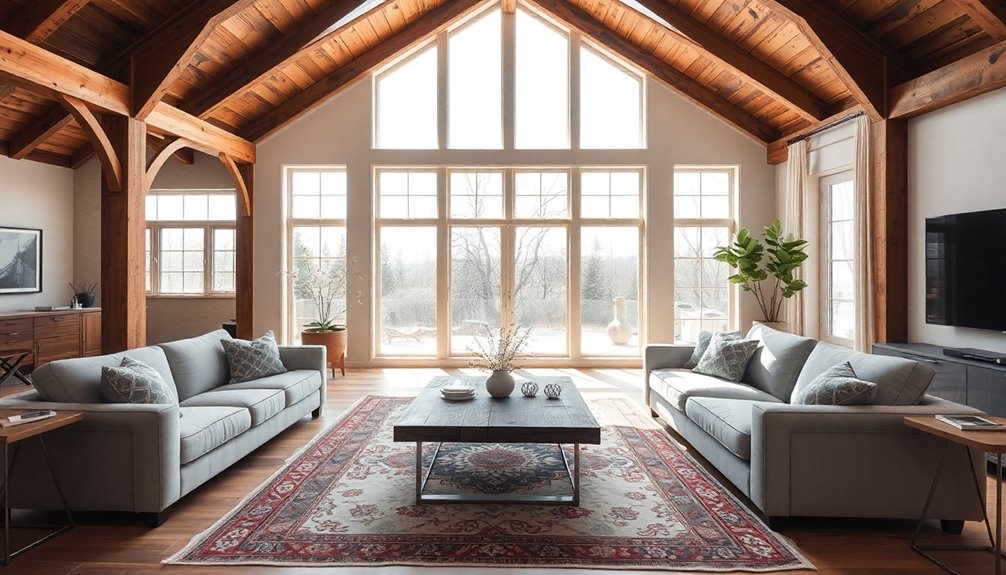
Achieving balance between rustic and modern features requires a thoughtful approach to design. Start by choosing a neutral color palette with earthy tones, then blend in sleek finishes like stainless steel and glass. This combination creates a harmonious backdrop for your space.
Incorporate a mix of textures to enhance visual interest. Pair rough wood furniture with smooth metal accents to add depth and intrigue. Vintage pieces, such as reclaimed wood tables or antique decor, seamlessly integrate charm and character without overwhelming the modern aesthetic. Adding handmade ceramics can provide unique touches that resonate with both styles.
Pay attention to the scale and proportion of your furnishings. Using appropriately sized pieces guarantees a cohesive look throughout the room. Consider strategically mixing statement elements from both styles; for instance, hang a modern art piece over a rustic wooden mantel to create a dynamic visual contrast.
These design ideas will help you masterfully blend rustic and modern elements while maintaining an inviting atmosphere. The key is to strike that perfect balance, allowing each style to shine without overshadowing the other. Additionally, incorporating natural materials like wood and stone can enhance the rustic feel while complementing modern touches.
With careful consideration, your space can radiate warmth and sophistication, showcasing the best of both worlds.
Functionality and Comfort Considerations
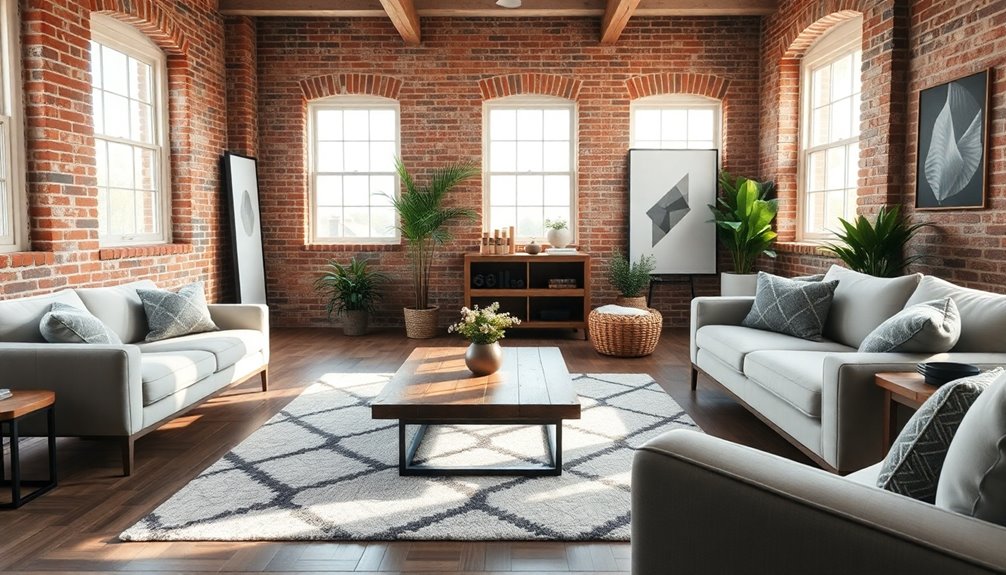
When it comes to blending rustic and modern styles, functionality and comfort are essential for creating a livable space. You can achieve this by incorporating multifunctional furniture, like ottomans with storage or extendable dining tables, which maximizes space efficiency while enhancing comfort. Additionally, consider using natural materials such as reclaimed wood and stone to enrich the tactile experience of your home. Regular maintenance of appliances, including essential safety equipment, can also enhance the overall functionality of your space by ensuring they operate efficiently and effectively.
Designing your layout to prioritize flow between living spaces encourages interaction, making your rooms feel more inviting and practical.
To establish a cozy atmosphere, utilize soft textiles—think throw blankets and plush pillows. These elements not only complement the ruggedness of rustic materials but also heighten overall comfort.
Implementing built-in storage solutions, such as open shelving and cabinetry, organizes your space effectively and adds visual appeal to your design.
Don't forget about natural light! Prioritizing large windows and skylights contributes to a serene environment, promoting comfort while blurring the lines between indoor and outdoor living. Additionally, incorporating smart bathroom technologies can further enhance comfort and functionality in your home. Understanding energy-efficient appliances can also play a crucial role in maintaining a comfortable atmosphere while keeping energy costs low.
Personalization in Design
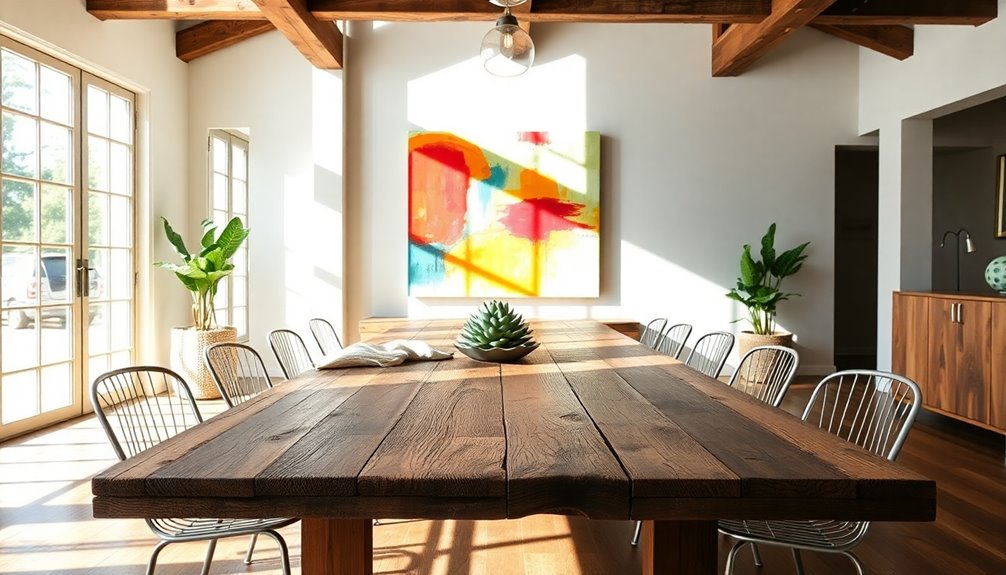
When you incorporate unique decor pieces, you create a space that tells your story.
Family heirlooms can serve as focal points, adding both sentimental value and character to your design.
Unique Decor Pieces
Incorporating unique decor pieces into your space can transform it into a reflection of your personality and experiences. These items, from vintage finds to handmade crafts, infuse personal stories that make your home feel more inviting.
Think about including travel souvenirs or artistic creations that serve as conversation starters. Custom elements, like personalized wall art or tailored furniture, enhance the rustic modern aesthetic by blending functionality with your personal style.
Mixing rustic decor, such as mason jars or wooden bowls, with modern art pieces creates a dynamic contrast, showcasing warmth and sophistication in one cohesive design.
Moreover, thoughtfully curated decor choices help maintain this balance while allowing for personal expression. Consider adding plants or unique accessories that not only elevate your space but also resonate with your experiences.
Family Heirlooms Integration
Integrating family heirlooms into your design can transform a space, adding layers of personal history and storytelling. These treasured items not only provide a personal touch but also enhance the rustic modern space's character and charm. By incorporating heirlooms like antique furniture or vintage decor, you create focal points that draw attention and spark conversations, all while blending seamlessly with contemporary elements.
Consider custom cabinetry designed to showcase your family treasures, allowing you to preserve history and promote sustainability by repurposing instead of purchasing new items. Thoughtful placement of these heirlooms generates visual interest and emotional depth, enriching the warmth of your environment.
| Family Heirlooms | Contemporary Elements |
|---|---|
| Antique furniture | Sleek, modern sofas |
| Vintage decor | Minimalist wall art |
| Handcrafted items | Geometric design accents |
| Heirloom textiles | Clean-lined lighting fixtures |
Sustainable Practices in Design
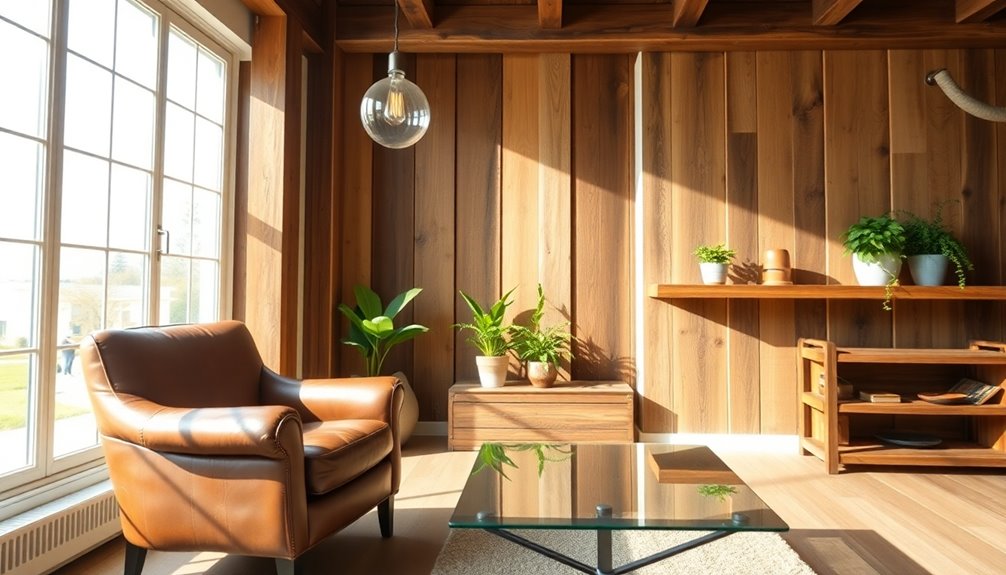
Amid growing environmental concerns, sustainable practices in design have become essential for creating spaces that are both stylish and eco-friendly. By incorporating reclaimed wood and other salvaged materials, you not only reduce waste but also add unique character to your rustic modern designs.
Choosing energy-efficient appliances can further enhance your commitment to sustainability, as these models consume up to 50% less energy than standard ones while maintaining a contemporary aesthetic.
You can also promote eco-friendly design by utilizing natural materials like organic textiles, including cotton and linen. These materials not only support sustainability but also enhance the overall texture and comfort of your space.
Implementing water-saving fixtures, such as low-flow faucets and dual-flush toilets, can greatly reduce water consumption by up to 30%, aligning perfectly with your eco-conscious goals.
Lastly, sourcing locally produced materials supports community economies and minimizes transportation-related carbon footprints.
Frequently Asked Questions
How Do You Blend Modern and Rustic?
To blend modern and rustic styles, start by combining natural materials like reclaimed wood and stone with sleek metals and glass.
Use a neutral color palette featuring earthy tones, and layer textures—think soft textiles against rugged surfaces.
Incorporate functional furniture that serves multiple purposes to maximize space.
Don't forget statement lighting fixtures that reflect both styles, unifying your design while enhancing the overall ambiance.
This approach creates a balanced and inviting atmosphere in your home.
What Is the Difference Between Rustic and Contemporary?
Imagine walking through a cozy cabin, where reclaimed wood beams hug the ceiling, exuding warmth.
That's rustic design. It embraces natural materials and earthy tones, creating a nostalgic vibe.
Now, picture a sleek, minimalist apartment with sharp lines and vibrant accents—this is contemporary design.
It prioritizes function and simplicity, often using synthetic materials.
While rustic feels inviting and layered, contemporary shines with a polished, uncluttered aesthetic.
Each style tells its own story.
